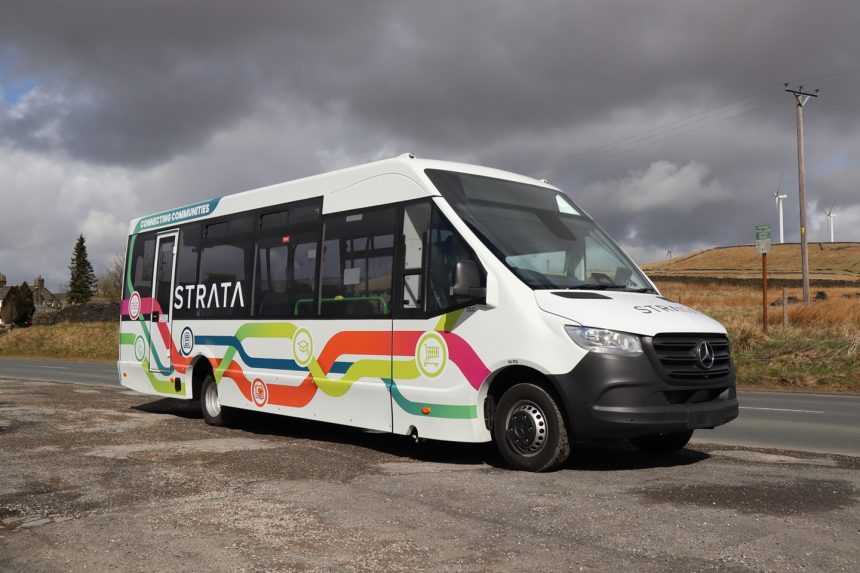Mellor has seen success with its coachbuilt low-entry Strata minibus since launch in 2016, and the product is now moving to a second generation for low-floor examples.
That work is described as much more than a facelift by John Randerson, who is CEO of parent company Woodall Nicholson. While it leverages Strata’s strengths in fuel efficiency and total cost of ownership, he adds that it was felt the right time to explore how the vehicle could be improved for passengers as well as operators.
“Our primary objective was to make a good small bus even better,” John explains, noting that revision of Strata is part of a pipeline of product development and new vehicle launches at Mellor and sister business Treka Bus during 2025 and into 2026.
Change has been made across all three low-entry Strata models – the standard vehicle, the slightly bigger Strata Plus, and the largest Strata Ultra. Key to the economy argument is a reduction of up to 150kg in unladen weight. The Ultra can carry 30 passengers, but now with up to 29 seated. The standard Strata in its latest iteration will have up to 22 seats, while the Plus will have a maximum of 26.
While Mellor otherwise keeps weights of the Strata close to its chest, John says that all necessary approvals are in place and that work done to the Sprinter base vehicle is fully supported by Mercedes-Benz UK with no impact on chassis warranty.
A lower unladen weight has been achieved using more stainless steel and composites, and by analysis of earlier Stratas to see where material could be removed without compromising longevity. Some of those have completed 500,000km and no fatigue failures have been reported.
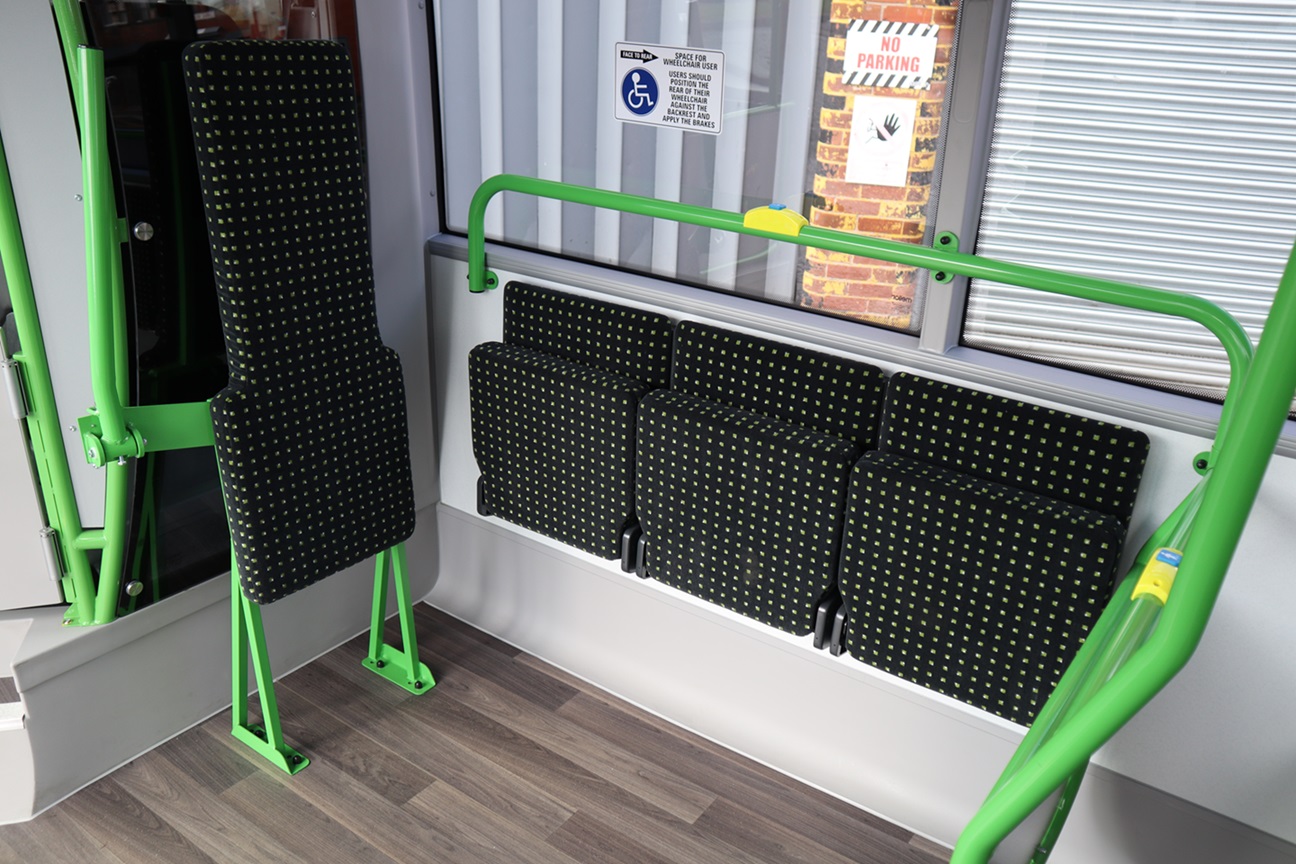
Within the saloon, the low floor space is bigger, permitting two wheelchair user bays where required. The rear area is now accessed via one step rather than two, and in the Ultra, the emergency door has been moved forward. That allows a five-across back row of seats. The Ultra also has back-to-back seat pairs above the rear wheels.
Mellor has completed a development second-generation Strata Ultra, with accelerated durability testing to be undertaken at UTAC Millbrook. That vehicle will also appear at the ALBUM conference in Nottingham on 12-14 May; demonstration of the new Strata with operators will commence in the summer. Before that, the manufacturer made the seed example available for test.
Variety of size options continue for new Mellor Strata
As an Ultra, the development minibus is the longest of the Strata range at 8.78m. The manufacturer notes how the Ultra has long been a popular member of the line-up, and its maximum 29 seats suggests that will continue.
Low Carbon Emission Bus certification by Zemo Partnership has been maintained in the latest Strata, which is built on a chassis that complies with the EU General Safety Regulation 2. Various sensors are in place as part of that; most are in the windscreen, but sideguard detection units are integrated by Mellor into skirting panels.

Sprinters are sourced as chassis cabs that first go to Woodall Nicholson business Promech Engineering at Scarborough for early work. They are completed at Mellor’s Rochdale factory. The manufacturer says that extensive customisation is available to suit the buyer’s needs.
Power in the Sprinter is from the 1,950cc OM 654 engine that develops 150bhp driving through a 9G-Tronic nine-speed automatic gearbox with stalk selection. Steel suspension is retained all round, with uprated springs at the rear.
Attractive passenger offer within overhauled model
While some things have changed on the new Strata, other elements are the same as they have been since launch nine years ago. A single-piece sliding door and a 350kg ramp are both from Ventura, while wood-effect flooring and high-backed seats as fitted to the development vehicle have both been used previously.
It has a single wheelchair user bay, located behind the driver and with three tip-up seats. Immediately behind the door on the nearside is a further bay for buggies with the same number of tip-up positions. That is a versatile area and can alternatively be configured for a second wheelchair user, or with two individual fixed seats.

As shown, six forward-facing seats and the same number of tip-up positions are accessed without reaching a step. The ascent to the rear area is shallow. Most notable there are the two bays of facing seats, brought about by the mounting of back-to-back pairs over the drive axle.
The rear row of five is quite snug in terms of space, as reflects the Strata’s width of 2.30m. Seats are from Kiel, and are compact in design, including backrest thickness. Dark moquette with green inserts has been specified; additions such as USB charging points and seatback bell pushes can be incorporated.
An Eberspächer auxiliary heater is among amenities. Saloon air-conditioning is optional; sliding window vents are fitted, along with twin ceiling-mounted strip lights.
Also present is necessary equipment for next-stop audio and visual announcements. Part of that are two screens; one at the front above the platform, and the other facing forward above the rear window. The latter takes account of wheelchair users and passengers in the rear-facing seats over the back axle. Handrails are powder coated in green.
Cab area in new Mellor Strata up to the job
The latest-generation Sprinter has a car-like cab area, with a small steering wheel. Chassis controls are built around the central MBUX infotainment unit. It is likely to be of limited relevance in bus applications, but items such as the cab heater and air-conditioning controls are below in more traditional format.
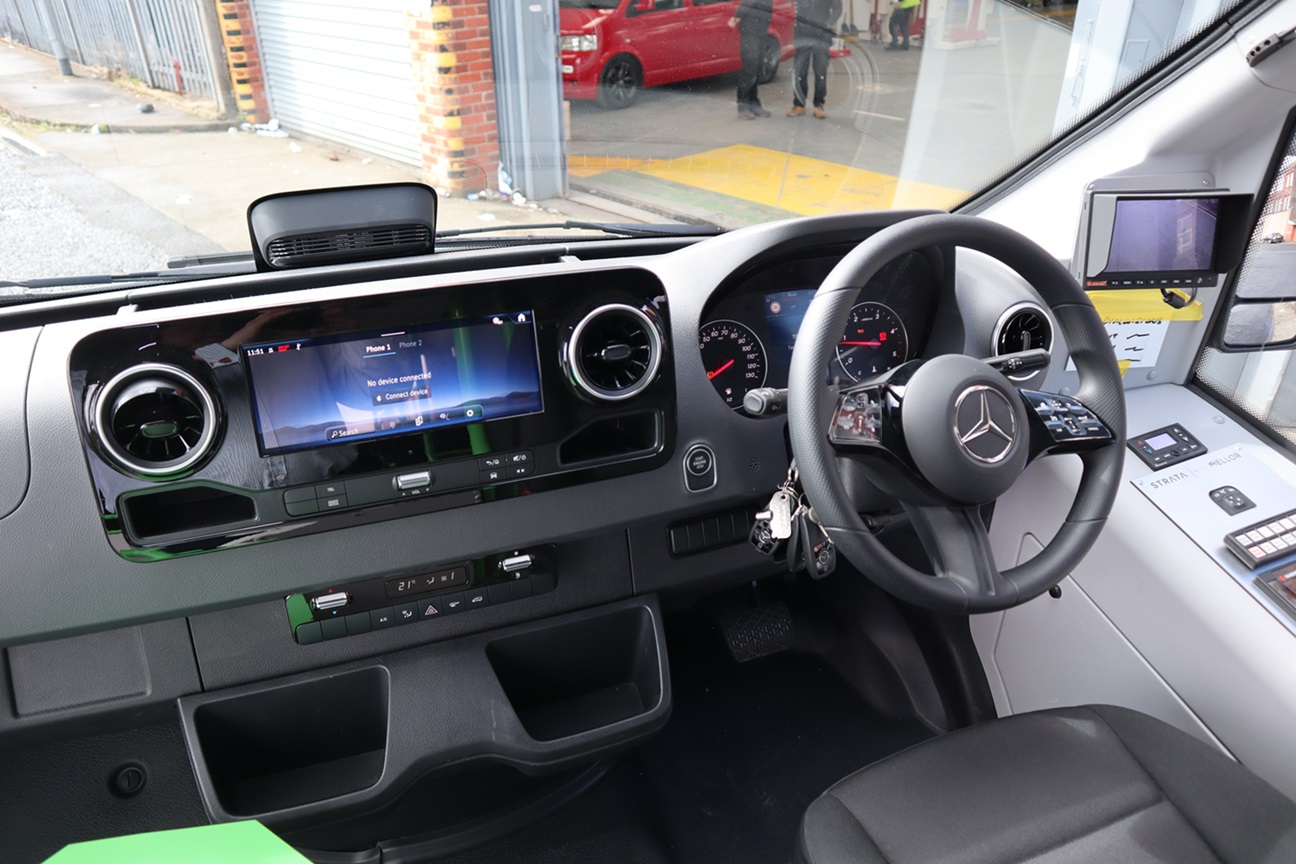
Mellor adds a console to the driver’s right under the signalling window for body controls, including door, lights, and such. Electric mirror adjustment, saloon heating and a reversing camera monitor are also there. The monitor is at the base of the A-pillar. That pillar is quite thick, and care is thus needed at junctions and roundabouts.
A single, electrically controlled windscreen sunblind is included, and the signalling window is secured by twin ‘squeeze’ catches. Those coupled to its position mean that it is only possible to adjust the window when stationary, although inclusion of cab air-conditioning mitigates the need to open it.
The driver’s seat has good adjustment, particularly to the rear. Access to the cab is via twin steps. The development vehicle has a magnetically secured cab door that is reasonably wide, but care is needed when entering or exiting so as not to snag clothes. A ticket machine mounting platform is to the left of the cab door. Mellor can include an anti-assault screen when needed.
Easy driving experience comes with a small bus
Driving the Strata is simple for staff used to larger vehicles. Once familiar with the controls it is easily handled. Visibility is largely good, and while a sub-two-litre engine is used by Mercedes-Benz, there is immediate get up and go.
Mellor does not offer a manual gearbox, and for good reason; the 9G-Tronic is excellent and with such a breadth of ratios could not be flustered.
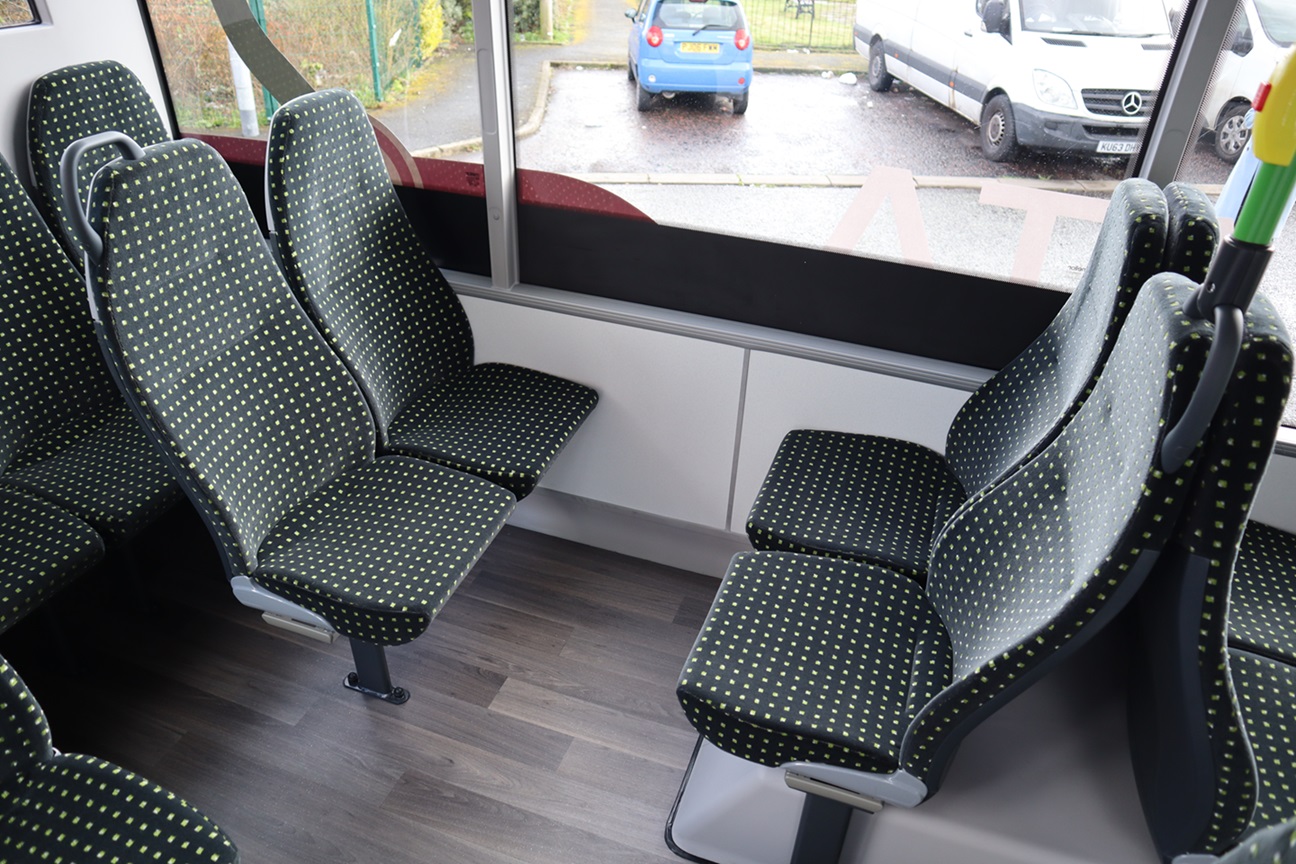
That included a climb out of Rochdale on the A680 towards Ashworth Moor Reservoir. Google Maps informs that the road rises by almost 440 feet over less than three miles, and that rate of ascent is particularly noticeable on some stretches.
While unladen, the Strata was able to hold the 30mph speed limit with no difficulty, although the engine was worked hard in doing so; the gearbox does not hesitate to take it beyond 3,000rpm when needed.
A return to Rochdale followed a similar route in reverse, and the descent was handled easily. No retarder is fitted, and the foundation brakes have a solid feel that permits smooth stops to be made.
Mercedes-Benz does a good job of insulating the cab and saloon area from engine noise. While more noticeable than on buses with the power unit at the rear, the tone of the OM 654 is not intrusive. How Strata suits lower-demand bus services was shown during the test, with examples in the First Manchester fleet seen around Rochdale providing Bee Network franchised services.
Part of a product journey for Rochdale manufacturer
John Randerson is a strong advocate of small buses, and his belief that they have a big part to play in the public transport landscape is immovable. He points to wider developments as an indication that Strata is increasingly well placed to capitalise on demand for diesel vehicles in that field; zero-emission will follow, but that is a longer-term project.
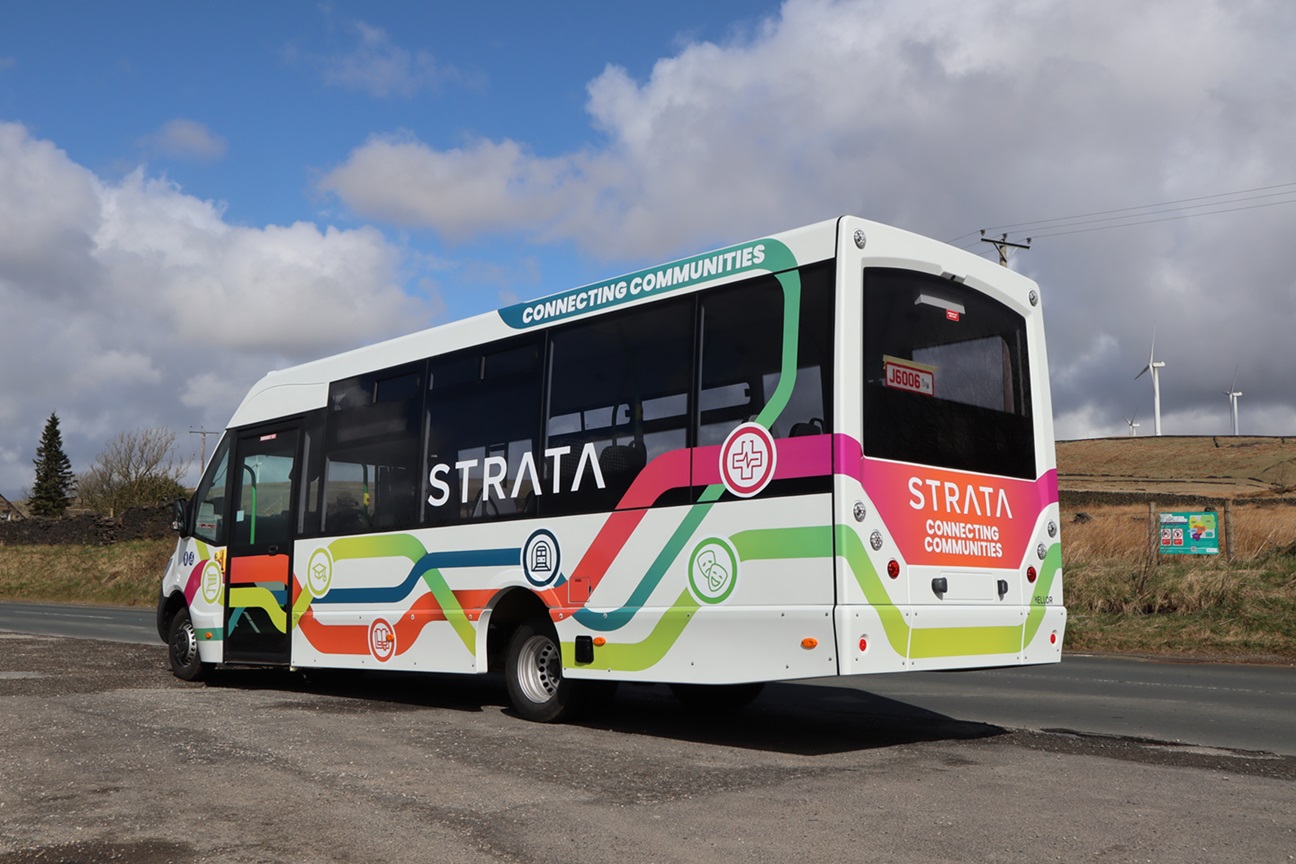
Ownership of Woodall Nicholson by industrialist Guido Dumarey has facilitated work on the Mellor and Treka ranges. He is a regular visitor to Rochdale and takes a close interest in product development, and that involvement has facilitated creation of what John calls “a product plan for small buses in the long-term.”
Mellor’s here and now in the public transport field is Strata. Orders are already in hand for the new-generation model and the builder eagerly anticipates showing it to bus operators at the ALBUM conference. Production is expected by August.
“The reasons to buy new Strata are the same as they have always been to buy Strata,” John continues. “It can not only deliver services in a cost-effective manner, but also stimulate passenger demand, and its fuel efficiency makes a contribution to decarbonisation even before we think about zero-emission.”
That belief is understandable; the latest-generation Strata Ultra is an admirable use of a lightweight base to deliver a competent and attractive small bus. It is well-equipped, plenty powerful, easy to drive, and highly accessible.
Facts and figures – Mellor Strata Ultra
Engine: 2.0-litre, four-cylinder Mercedes-Benz OM 654
Power: 112kW (150bhp) @3,800rpm
Torque: 340Nm (251 lb ft) @1,500-2,400rpm
Emissions: Euro VI using EGR and SCR
Gearbox: Mercedes-Benz 9G-Tronic nine-speed automatic
Tyres: 205/75 R16
Length: 8.78m
Height: 2.76m
Width: 2.30m
Wheelbase: 5.10m
GVW: Not disclosed
UVW: Not disclosed
Fuel economy: Not yet known





















